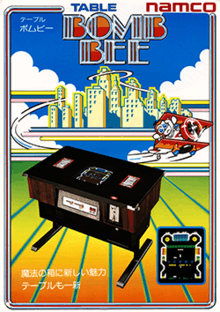Bomb Bee
Bomb Bee[lower-alpha 1] is a Japanese arcade game that was released by Namco in 1979. It is the sequel to Gee Bee, which was released in the previous year.
| Bomb Bee | |
|---|---|
 | |
| Developer(s) | Namco |
| Publisher(s) | Namco |
| Designer(s) | Toru Iwatani |
| Programmer(s) | Shouichi Fukatani[1] Shigeichi Ishimura |
| Series | Gee Bee |
| Platform(s) | Arcade |
| Release |
|
| Genre(s) | Block breaker, video pinball |
| Mode(s) | Single-player, multiplayer (alternating turns) |
| Cabinet | Upright, tabletop |
| Arcade system | Namco Warp & Warp |
| CPU | Intel 8080 |
Gameplay

The maximum number of players is two, and the two players have to alternate. The control is a rotary analog stick. The main object of the game is to move two paddles that ricochet a ball which flies around and needs to hit the colored bricks above it. When the bricks are cleared out of the side sections, it will turn that same side's pop-bumper into 100 points instead of 10. It is a bonus multiplier to get the ball to light up the word "NAMCO".[2]
Reception and legacy
| Reception | ||||||
|---|---|---|---|---|---|---|
| ||||||
Bomb Bee was not a success when it was released. According to Matt Barton, the author of the book Vintage Games 2.0, the game did not sell well and likely sold the same amount of machines as Gee Bee, a game that didn't meet sales expectations either.[4] The success of Namco's later release Galaxian, a revolutionary shooting game, is believed to have contributed to its failure.[5] When Galaxian proved successful, Namco offered to bundle Bomb Bee machines with Galaxian to arcade owners in order to clear inventory.[5]
Retrospectively in 1998, Earl Green of AllGame said that outside a few minor differences, Bomb Bee was largely the same as its predecessor. However, he noted that the game's usage of a full-color display, and being among the earliest creations by Toru Iwatani, made the game of historical value.[3] In his blog Before Mario, Erik Voskuel says that Bomb Bee marks the first collaboration between Namco and Nintendo, two developers that would work together on many more titles, making it a historically-significant game. Voskuel also says that Bomb Bee is notable for being the first appearance of a third-party title on a Nintendo console, and being among Iwatani's earliest creations before Pac-Man.[6]
Notes
References
- Szczepaniak, John (11 August 2014). The Untold History of Japanese Game Developers (First ed.). p. 201. ISBN 978-0992926007. Retrieved 12 August 2019.
- "Bomb Bee". The International Arcade Museum. Retrieved 2012-12-28.
- Green, Earl (1998). "Bomb Bee - Review". AllGame. All Media. Archived from the original on 15 November 2014. Retrieved 8 July 2020.
- Barton, Matt (8 May 2019). Vintage Games 2.0. CRC Press. p. 55. ISBN 9781000000924. Archived from the original on 9 July 2020. Retrieved 9 July 2020.
- "『ワニワニパニック』開発者からグループ会長にまで上り詰めた男が語る、ナムコ激動の40年。創業者・中村雅哉との思い出、バンダイ経営統合の舞台裏【バンダイナムコ前会長・石川祝男インタビュー:ゲームの企画書】". Nico Nico News (in Japanese). Niconico. 14 September 2018. Archived from the original on 5 April 2019. Retrieved 9 July 2020.
- Voskuel, Erik (30 September 2012). "Nintendo / Namco Bomb Bee-N (ボムビーN, 1979)". Before Mario. Archived from the original on 17 December 2014. Retrieved 9 July 2020.